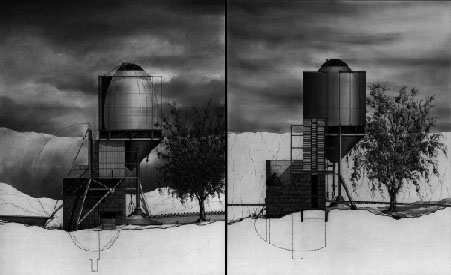 [Image: Douglas Darden, the Oxygen House; courtesy of the Darden Estate, via Part].
[Image: Douglas Darden, the Oxygen House; courtesy of the Darden Estate, via Part].While writing the previous post, I stumbled across a project called the Oxygen House, by Douglas Darden.
 [Images: Douglas Darden, the Oxygen House; courtesy of the Darden Estate, via Part].
[Images: Douglas Darden, the Oxygen House; courtesy of the Darden Estate, via Part].In an otherwise almost unreadable essay, we learn that Darden, "a young and very talented architect, designed the house for Burnden Abraham, a disabled signalman for the Southern Pacific railroad, on a site near Frenchman's Bend in rural northern Mississippi. The drawings were completed in 1998. Abraham died shortly after the footings for the house were poured. The construction of the house was abandoned."
 [Images: Douglas Darden, the Oxygen House; courtesy of the Darden Estate, via Part].
[Images: Douglas Darden, the Oxygen House; courtesy of the Darden Estate, via Part].Intriguingly, the client was actually "confined to an oxygen tent because of disabling chest injuries":
- Those injuries were caused by the derailment of a Southern Pacific train on precisely the spot that was later intended as the site for his house. The house he wanted was to be his oxygen house: a shelter and setting that would sustain and support his life. It was to be, quite literally, the place that "held" his breath and gave him life.
 [Images: Douglas Darden, the Oxygen House; courtesy of the Darden Estate, via Part].
[Images: Douglas Darden, the Oxygen House; courtesy of the Darden Estate, via Part].The client, however, is a fictional construct: Darden invented the client based on a passage from William Faulkner's As I Lay Dying – a novel that presents us with "the death of Addie Bundren," as well as "the saga of her burial."
Darden's fake client is, of course, named Burnden Abraham.
From the essay: "If one reads the first chapter of As I Lay Dying carefully, and then reads the [client's letter to the architect] attentively, one cannot help but be struck by the correspondences and analogies that appear. Abraham's letter – or rather Abraham's letter as Douglas Darden writes it – takes the first chapter of Faulkner's novel, isolates, and subtly changes some of its phrases. It then weaves them back together" to form the client's approach to the architect.
(Note: This post updated on February 2nd, thanks to a tip from David Maisel).
No comments:
Post a Comment